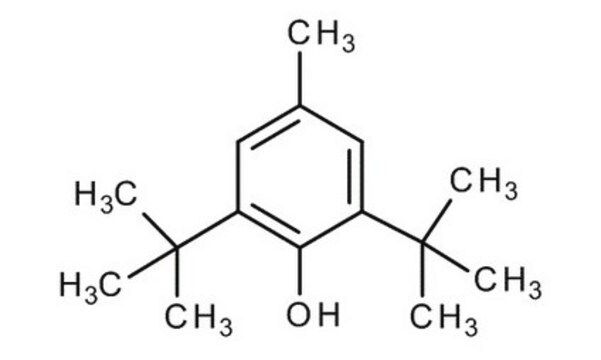B1215000
2,6-Di-tert-butyl-4-methylphenol
European Pharmacopoeia (EP) Reference Standard
Sinónimos:
2,6-Di-tert-butyl-4-methylphenol, 2,6-Di-tert-butyl-p-cresol, BHT, Butylated hydroxytoluene, Butylhydroxytoluene, DBPC
About This Item
Productos recomendados
grado
pharmaceutical primary standard
densidad de vapor
7.6 (vs air)
presión de vapor
<0.01 mmHg ( 20 °C)
temp. de autoignición
878 °F
fabricante / nombre comercial
EDQM
bp
265 °C (lit.)
mp
69-73 °C (lit.)
aplicaciones
cleaning products
cosmetics
food and beverages
personal care
pharmaceutical
formato
neat
temp. de almacenamiento
2-8°C
cadena SMILES
Cc1cc(c(O)c(c1)C(C)(C)C)C(C)(C)C
InChI
1S/C15H24O/c1-10-8-11(14(2,3)4)13(16)12(9-10)15(5,6)7/h8-9,16H,1-7H3
Clave InChI
NLZUEZXRPGMBCV-UHFFFAOYSA-N
¿Está buscando productos similares? Visita Guía de comparación de productos
Descripción general
Aplicación
- Multicomponent analysis of fat- and water-soluble vitamins and auxiliary substances in multivitamin preparations by qNMR.: This study utilizes Butylhydroxytoluene (BHT) as an auxiliary substance for its antioxidant properties in multivitamin preparations. The research demonstrates the effectiveness of BHT in maintaining the oxidative stability of vitamins, ensuring their longevity and efficacy in pharmaceutical applications (Eiff et al., 2015).
- Investigation of the stabilizing effects of antioxidants and benzophenone-3 on desonide photostability.: The study explores the use of BHT as an antioxidant to enhance the photostability of desonide. Findings indicate that BHT significantly improves the stability of the compound under light exposure, making it a valuable preservative in pharmaceutical and biotechnological formulations (Rosa et al., 2014).
- Understanding the molecular aspects of tetrahydrocannabinol and cannabidiol as antioxidants.: This research highlights BHT′s role as a comparative antioxidant in studying the properties of cannabinoids. BHT′s well-documented antioxidant mechanisms provide a benchmark for evaluating the efficacy of other compounds in oxidative stress research (Borges et al., 2013).
- Kinetic study of the quenching reaction of singlet oxygen by common synthetic antioxidants.: The kinetic analysis of BHT′s ability to quench singlet oxygen demonstrates its superior antioxidant capabilities compared to other synthetic antioxidants. This property is crucial for developing pharmaceutical formulations that require high oxidative stability (Kim et al., 2009).
Envase
Otras notas
Producto relacionado
Palabra de señalización
Warning
Frases de peligro
Consejos de prudencia
Clasificaciones de peligro
Aquatic Acute 1 - Aquatic Chronic 1
Código de clase de almacenamiento
11 - Combustible Solids
Clase de riesgo para el agua (WGK)
WGK 2
Punto de inflamabilidad (°F)
260.6 °F - open cup
Punto de inflamabilidad (°C)
127 °C - open cup
Elija entre una de las versiones más recientes:
Certificados de análisis (COA)
Lo sentimos, en este momento no disponemos de COAs para este producto en línea.
Si necesita más asistencia, póngase en contacto con Atención al cliente
¿Ya tiene este producto?
Encuentre la documentación para los productos que ha comprado recientemente en la Biblioteca de documentos.
Los clientes también vieron
Protocolos
HPLC Analysis of Phenolic Antioxidants on Ascentis® Express C18 2.7 μm
Nuestro equipo de científicos tiene experiencia en todas las áreas de investigación: Ciencias de la vida, Ciencia de los materiales, Síntesis química, Cromatografía, Analítica y muchas otras.
Póngase en contacto con el Servicio técnico








